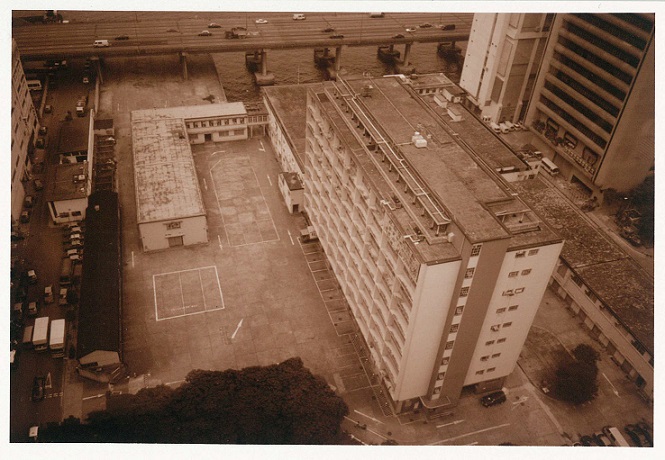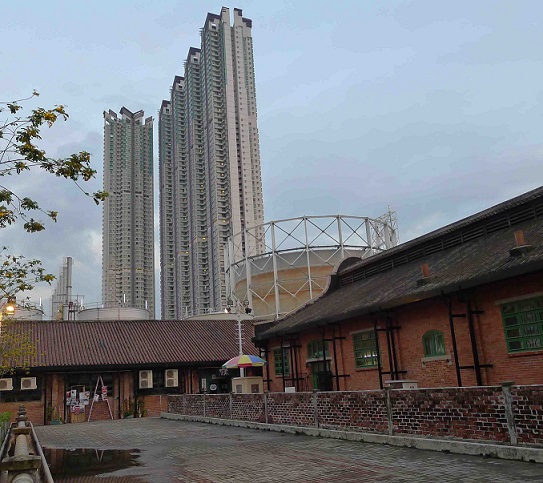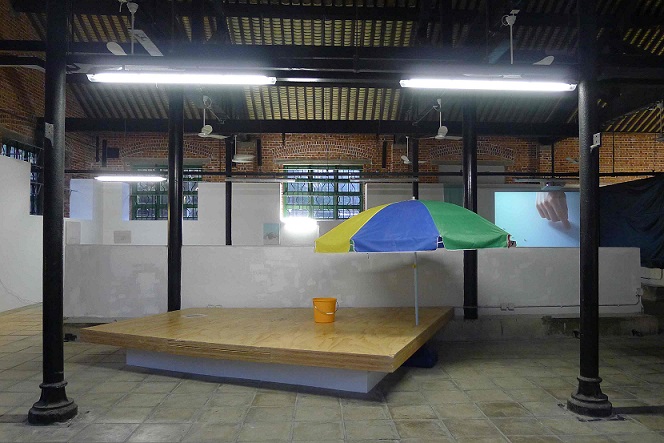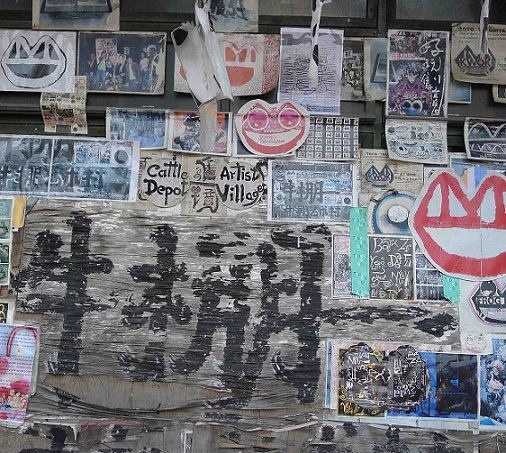Reviews & Articles
Oil Street 1998 and Non-profit Art Spaces Now
John BATTEN
at 11:07am on 17th February 2015





Captions:
1. Birds-eye view of former Government Supplies Depot at Oil Street, North Point, late 1990s (now demolished). Photograph courtesy of Almond Chu.
2. Para Site (formerly Para/Site Art Space), after closure 2014 just before relocating to North Point in 2015. Note the original Para Site location in Sheung Wan is building on right with red awning (each building was exactly the same size and similar layout).
3. Cattle Depot, Tokwawan, Kowloon - central courtyard looking towards present Videotage space. Main gallery space on right, formerly the home of Artists' Commune, 2014.
4. Interior view of main gallery at Cattle Depot during Lee Kit's exhibition (based on his Venice Biennale presentation), 2014.
5. Exterior of Kwok Mang-ho's (Frog King) studio, Cattle Depot, Kowloon, 2014.
(all other photographs: John Batten)
(原文以英文發表,題為「1998年油街和現今非牟利藝術空間」。)
Para Site, the high profile non-profit art space, founded in 1996, has moved from Sheung Wan and soon opens a larger exhibition space in North Point. This reminded me that Hong Kong’s current art scene and most of its non-profit art spaces have their origins from the late 1990s – and, it should not be forgotten, as a consequence of government policies from that period. People talk about Hong Kong’s current vibrant art scene. Sure, the art market, certainly auction houses, has a buzz, but it does not compare to the artistic excitement of the late 1990s.
Para Site was originally founded by a group of like-minded, determined and organised artists that applied for some of the first arts funding available from the then newly established Hong Kong Arts Development Council (HKADC) in the mid-1990s. The funding was meager, however on a shoestring budget and proudly proclaiming itself as an “artists’ run space”, Para Site was able to have its rent, exhibition installation and administrative staffing costs publicly funded.
At around the same time, the former Government Supplies Depot warehouses in Oil Street, North Point were advertised with very affordable rent on short-term leases. Word quickly spread around Hong Kong’s arts community that these Oil Street spaces were ideal for studio and gallery accommodation. Over a frantic few weeks, established arts groups Zuni Icosahedron and Videotage and new groups Artist Commune and 1aspace took space and started organising their own art exhibitions. Throughout the many Oil Street buildings, other artists - including Almond Chu, Kwok Mang-ho and Kacey Wong – also rented spaces, as did other businesses: architecture, photographic and artisan studios. Oil Street was Hong Kong’s first arts community. It was vibrant, organic and successful. All of these groups and some artists received HKADC grants – but the crux of its success was space: cheap rent and a flexible use policy e.g. not restricted to only ‘clean’ uses; artists could paint and make their spaces dirty.
Oil Street unofficially opened with a late-night weekend arts event. If it had actually been organized, it would have been - certainly nowadays - promoted as a ‘festival’ with posters and sponsors. But, Oil Street was just organic, there was no central organiser – so, in the days prior to Oil Street’s opening, word-of-mouth was intense: fax messages, telephone calls and invitations to films screenings and BBQs ensured a strong turnout. A range of people came, many from what is now identified as the ‘creative industries’ and their friends, wandering around the abandoned high-ceilinged rooms of the former Government Supply Depot, visiting exhibitions and installations in the rented spaces. It was the beginning of a short, intense and heady time for Hong Kong’s art scene.
Over a period of eighteen months, Oil Street saw many visual arts, theatre, music, performance and film events held in and around its many spaces. Para Site, new to its own Sheung Wan space, was also incredibly active. Para Site had a policy of only hosting art installation and performance events – they intentionally had no conventional painting or wall-based exhibitions. In the early days, Para Site’s primary focus was installations done by its own artist members and friends, with Hong Kong itself as the main topic. At the time of Hong Kong’s handover to the mainland, the young artists who exhibited in Para Site explored a range of issues around ‘Hong Kong’ and its colonial and Chinese heritage and the personal, often confusing, identity of Hong Kong people. Ironically, 2014 saw many of the same issues being re-examined.
These new, independent art spaces were exciting because the established museums and most commercial galleries were incredibly conservative in their exhibition programming and attitude towards contemporary art and political, social and aesthetic issues. Urgent calls for a contemporary art museum began in these years, and the eventual establishment of West Kowloon’s M+ has its origins from this time.
The vibrancy of Oil Street ended in 1999 when the government announced that the former Government Supply Depot would be sold for development and all leases, albeit short-term, would end. There was an outcry from many of the incumbent Oil Street artists and arts group. Eventually, the former To Kwa Wan abattoir with its historic century-old buildings was offered as a replacement arts venue. Known as the Cattle Depot, some individual artists and Videotage, 1aspace and Artist Commune transferred their exhibition spaces and remain active today. Zuni Icosohedron took only office/rehearsal space. Artist Commune has since closed and their venue, the largest building at the Cattle Depot, has been further renovated and M+ used it last year as a venue to exhibit the work of Lee Kit, Hong Kong’s 2013 Venice Biennale representative.
The Hong Kong non-profit arts space landscape has largely remained unchanged since the 1990s. There are almost no new non-profit art spaces and the vibrancy seen in the 1990s has waned. New impetus is needed! Para Site’s move to North Point breaks its long association with Hong Kong’s western district – let’s hope this move jumpstarts its own vitality and rubs off on other art spaces or inspires a new group of idealistic artists to take the plunge and open a new art space that challenges everything – again.
A version of this essay was published in The Peak magazine, February 2015.
